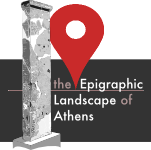Conference presentations #2019
VI Seminario di Epigrafia Greca (Venezia 16-18 Jan 2019)
17 Jan
Relators: Chiara LASAGNI Stefano TROPEA
Title of the speech:
«Il paesaggio epigrafico di Atene. Iscrizioni pubbliche e spazio urbano
nell'Atene medio e tardo ellenistica»
ABSTRACT:
An overview of the places of display of the most important Athenian public inscriptions between III and I cent. BCE will be the occasion to present, through some specific case studies, the research work carried out by The Epigraphic Landscape of Athens Project (www.epigraphiclandscape.unito.it).
Part #1 : «"Atene liberata" nel paesaggio epigrafico del III sec. a.C.» - (C.Lasagni)
In the III century Athens, the years 287-262 BCE and 229-200 BCE were characterised by similar ideological backgrounds, both focused on the recovery of the independence from the Macedonian domination, and marked by a spirit of general civil and religious reconstruction. Fostering citizens’ philotimia and enhancing stable ties with foreign benefactors (first of all, the Ptolemaic kings) became major concerns in both these periods, in order to safeguard the independence and cohesion of the Athenian polis. These aspects naturally shaped the city epigraphic landscape, in which the increasing centrality of the Agora as a place for displaying state decrees, alternative to the Acropolis, can be at least partly explained with the pivotal role of public epigraphy as a means of civic education.
Part #2: «Il paesaggio epigrafico di Atene tra il II e il I sec. a.C.: elementi di continuità con l'età ellenistica» - (S. Tropea)
Between the II and the I cent. BCE, in the Greek world shaped by the Romans after 168 and 146 BCE, the epigraphic landscape of Athens appears to undergo an evolution that paralleled the redefinition of political relationships both outside and inside the polis. In this period, it was again on the honours to local individuals and groups that the Athenian institutions concentrate their epigraphic communication in the attempt to provide the community with several exempla of virtuous citizens. On the other hand, the tendency to exploit the Agora as a place for display of public inscriptions was further strengthened. In this respect, a special focus will be placed on the eastern section of the Agora, that became more and more crowded with inscribed stelai, statues and portraits linked with the ephebate. The possibility to fix the original location of those honorific decrees by the Stoa of Attalos will be particularly discussed through maps and images.
Click here for the full programme.
Published on: 8 May 2019 by Chiara Lasagni



